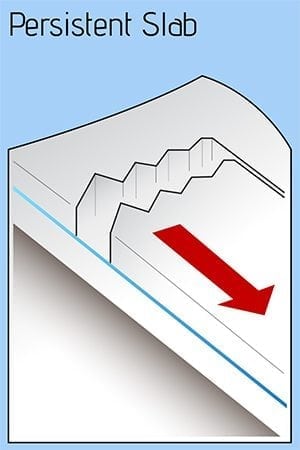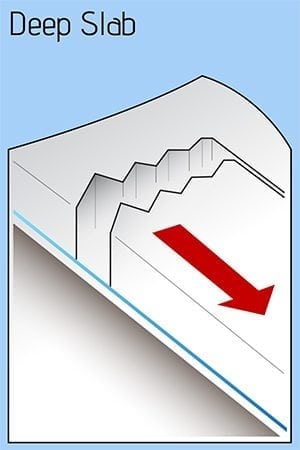Valdez
Above 4,000ftModerate
2,000 to 4,000ftModerate
Below 2,000ftLow
Degrees of Avalanche Danger
Avalanche Problems
Problem 1
The 1/14 buried surface hoar that was the weak layer responsible for the most recent natural avalanche cycle has been found on all aspects above 2500′ in the intermountain and continental zone, but not the maritime zone. This layer is widespread, is buried 1.5-3 feet deep, and is stubborn to unreactive. Stability tests have had mixed results as of late. The grain in question is becoming more difficult to locate, has showed signs of rounding (strengthening), laying flat, and being mixed with rounds from beneath. All signs are pointing towards this layer being dead or dormant. Except for the fact that surface hoar is notorious for surprising users and remaining reactive for long periods of time even after periods of dormancy. We are leaving this layer on our list due to the potential for large to very large avalanches that would occur should this layer fail.
It looks as though there is the possibility of a stronger storm arriving at the end of the weekend. This would once again test the strength and reactivity of this layer.
Likelihood:
- Almost Certain
- Very Likely
- Likely
- Possible
- Unlikely
Size:
- Historic
- Very Large
- Large
- Small
Trend
- Increasing
- Steady
- Decreasing
Problem 2
Weak snow exists near the base of our snowpack in all three climate zones. A step down avalanche occurred during the 1/23-25 storm on Nicks Buttress / ~3500’/ north aspect (see avalanche activity section). The was the first activity at this layer since 1/6, but does show that weak snow near the base of the snowpack can still produce avalanches.
Faceted snow near the ground has been found to vary significantly from place to place. In most locations this snow has been found to be rounding (gaining strength) and unreactive in stability tests. In thin areas of the snowpack these facets are significantly more developed. On 1/31 a very thin snowpack was found (28-36 inches) ~4000′ on Nicks buttress/North aspect. Stability tests produced propagation near the ground failing on 6mm depth hoar. The most likely places to affect weak snow near the ground will be in areas where the snowpack is thin.
If you find it is possible to push a ski pole to the ground in areas you travel. Assume that a weak faceted snowpack exists in that location, that could act as a trigger point.

Depth hoar from Nicks Buttress ~4000′ North aspect 1/31.
Likelihood:
- Almost Certain
- Very Likely
- Likely
- Possible
- Unlikely
Size:
- Historic
- Very Large
- Large
- Small
Trend
- Increasing
- Steady
- Decreasing
Avalanche Activity
Below is a summary of observed Avalanche activity from the last 7 days. Avalanches that were noted earlier in the season can be viewed by clicking the link below.
If you trigger or observe a natural avalanche consider leaving a public observation.
No avalanches reported or observed in the last 7 days.
Weather
Check out our updated weather tab! A collection of local weather stations are available for viewing with graphs and tabular data included.
NWS Watches and warnings
NONE NWS Point forecast for Thompson Pass
Date Friday 02/03/23 Saturday 02/04/23 Time (LT) 06 12 18 00 06 12 18 00 06 Cloud Cover OV OV OV OV OV OV OV OV OV Cloud Cover (%) 95 95 95 95 95 95 70 85 70 Temperature 16 20 22 18 17 21 20 14 13 Max/Min Temp 24 17 23 13 Wind Dir SE S S SE SE E S SE SE Wind (mph) 4 3 2 3 3 4 6 3 3 Wind Gust (mph) Precip Prob (%) 50 50 60 40 60 80 50 40 10 Precip Type S S S S S S S S 12 Hour QPF 0.12 0.08 0.21 0.03 12 Hour Snow 0.5 0.5 2.5 0.0 Snow Level (kft) 0.2 0.2 0.1 0.0 0.0 0.0 0.0 0.0 0.0
Click on link below for Thompson Pass weather history graph:

| Date:
02/03 |
24 hr snow | HN24W* | High temp | Low temp | 72 hour SWE* | February snowfall | Seasonal snowfall | Snowpack Depth |
| Valdez | 3 | N/O | 32 | 29 | N/O | 1 | 146 | 41 |
| Thompson pass | N/O | N/O | 23 | 15 | 0 | 0 | 286 | 48 |
| 46 mile | N/O | N/O | 25 | 14 | N/O | N/O | ~66** | 38 |
*HN24W- 24 hour Snow water equivalent in inches
*SWE– Snow water equivalent
**46 mile seasonal snowfall total begins December 1st.
Additional Information
Click on the link below for a running summary of the seasons weather history.
Announcements
The avalanche hazard is Moderate above 2000 feet and low below for the Intermountain and Continental zones. There remains the small chance of triggering an avalanche 1.5-3 feet deep. Avalanches may be able to step down to deeper layers in the snowpack in isolated locations. Shallow instabilities may also exist near high elevation ridge lines. Areas where the snowpack is thin, steep convex or unsupported terrain will be the most likely areas to trigger an avalanche.
Posted by Gareth Brown 02/03 7:45 am.
For a description of current avalanche problems, weather information, season history and more click the (+ full forecast) button. Avalanche forecasts will be issued Wednesday-Sunday.
If you have pictures of recent natural or human triggered avalanches or notice signs of instability such as shooting cracks or collapsing, leave an observation to help improve forecast accuracy.

